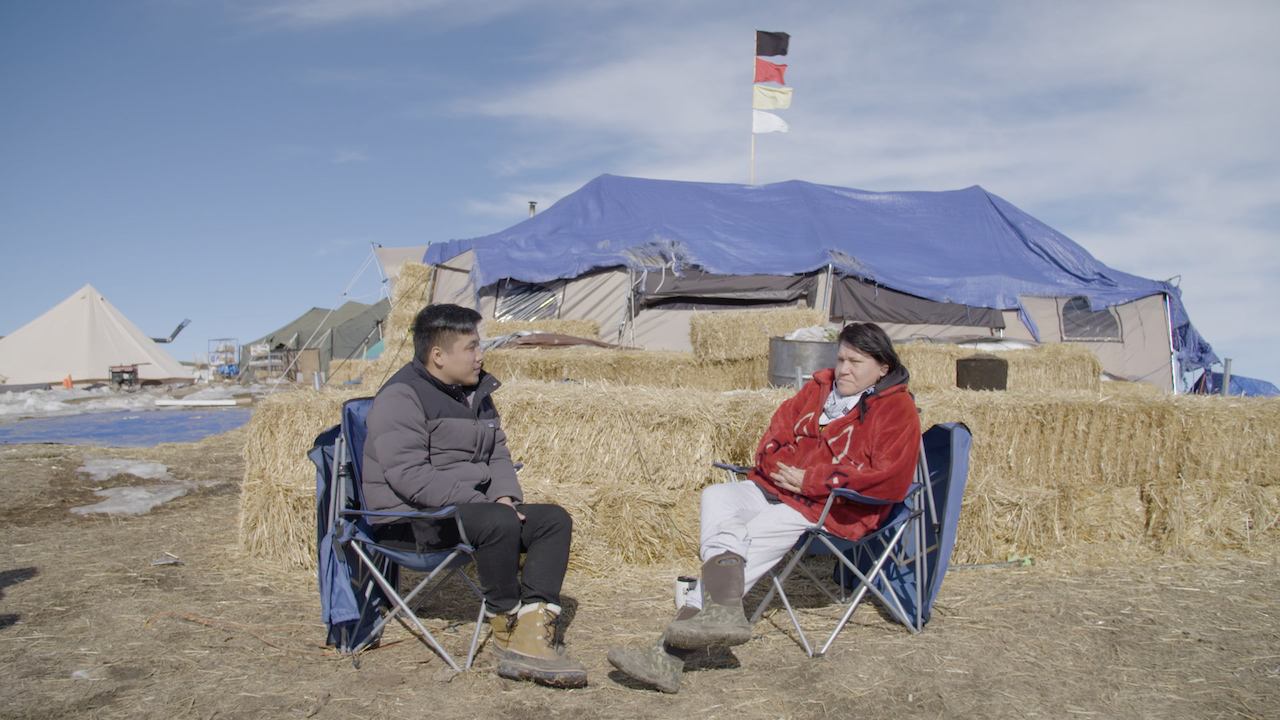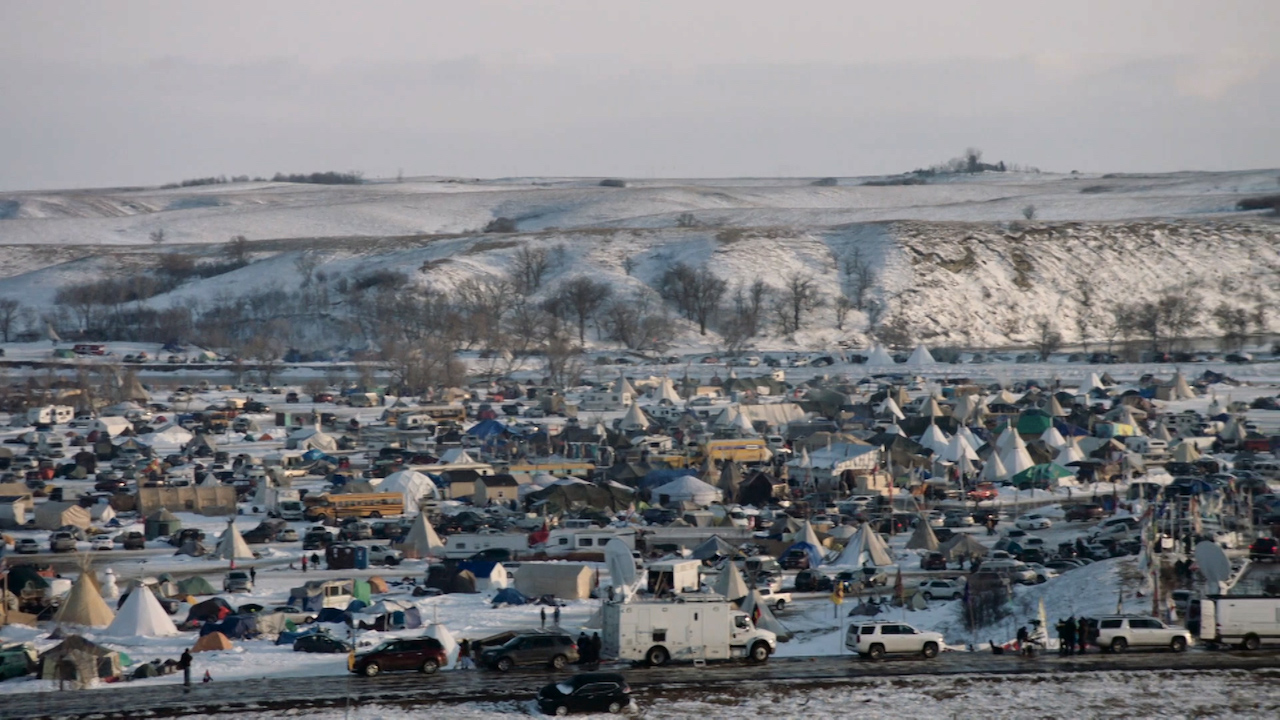Nancy Shomin first came to Standing Rock back in September after a stint in recovery for alcoholism. She was born in Flint, Michigan, and had been the only Native girl in her elementary school. Her father couldn’t stop Nancy’s classmates from bullying her, but he tried to balance his daughter’s loneliness with a steady exposure to tribal customs and rituals. Her life had been spent in and out of institutions — prison, rehab, therapy. In rehab, Nancy tried to process what had happened to her during a violent childhood, but she found that she was constantly doubting the accuracy of her memories. She decided to head to Standing Rock because a friend had put out a call on Facebook. When Nancy first saw the line of tipis by the Missouri River, she felt the neurosis of recovery melt away.
Nancy quickly committed herself to life as a water protector. She went on marches to the pipeline construction site, got arrested, and spent time in jail. Whenever she would leave camp to see her family back in Michigan, she felt a creeping unease — what was she missing back in camp? Did the resistance still need her? She kept coming back to North Dakota and started picking up the camp’s dual languages of activism and spirituality. She was no longer at Standing Rock to block the construction of the pipeline and protect the waters of the Missouri River from contamination but also to decolonize herself in a sacred space of prayer. At the front lines, where water protectors faced off with Morton County sheriff’s deputies and the National Guard, Nancy played the role of a “watcher” — she made sure the situation was in some semblance of control.
Videos by VICE
“There’s always one or two policemen who break away from the line,” she said. “And they’re the ones you have to watch out for because something in them has broken, and they’re going to be the ones who will respond violently to a prayerful protest.”
In early December, however, after the Army temporarily blocked the construction of the Dakota Access Pipeline, the Standing Rock Sioux leadership asked people to return to their homes. They said they would fight any future battles in court. Nancy didn’t leave because she did not believe that the “victory” was a permanent one, especially with Donald Trump coming into office. Rumors were flying around that the tribe had been paid off by the state of Nevada, by the company building the pipeline, by the incoming presidential administration. But a blizzard in early December and the implicit hierarchies at Standing Rock, which did not allow activist organizations to question tribal leadership, pushed most people out. Nancy watched as the infrastructure of Oceti Sakowin — the young lawyers, the bearded hippie builders, the cheery kitchen staff, the roving security force — all left along with the most of the 4,000 veterans who had crashed into North Dakota the weekend of the Army’s announcement as part of a doomed, nightmarishly disorganized campaign spearheaded by Wesley Clark Jr., the screenwriter son of the three-star general who ran for president, and Michael Wood Jr., a former Marine-turned-whistleblower with the Baltimore Police Department.
By early February, just two weeks after Trump signed a presidential memorandum to expedite construction of the pipeline, the ten thousand who had been in camp for the Army’s announcement had been weeded down to a few hundred. Then, in compliance with his executive action, the Army Corps of Engineers reversed the previous decision and granted the final permit necessary to complete the pipeline.
A spell of unseasonably warm weather had started to melt the sheet of ice that covered camp throughout the winter and turned the ground at Oceti Sakowin into a bog of broken tents, coolers filled with rotting food, and abandoned, busted cars. A small network of tractors, backhoes, and dump trucks began to enter camp to start clearing away the tons of garbage. The putter of heavy machinery and the crashes of big bits of trash being dropped into a dumpster replaced the constant chatter of the camp. Nancy found a spot on higher ground and shacked up in an old Army tent with a few friends.

Now, the resistance at Standing Rock is on its last legs: The legal challenges have gone unheeded. Tribal leadership has gone silent. The activist journalists that were sending out live streams from the front lines have gone off with the rest of the media to cover the Trump presidency. At the Grammy Awards, Paris Jackson said to a cheering crowd, “We could use this kind of excitement at a pipeline protest, guys.” And then, awkwardly pumping her fist, she said, “Hashtag no DAPL.” She was talking about a ghost — there is no more protest at Standing Rock, and the people left at camp are split between those who have already resigned themselves to the inevitability that the pipeline will be built and those who talk to one another about some miracle they hope will still come down the line.
In early February, the Army Corps told everyone to clear out of Oceti Sakowin by Feb. 22. Back in December, that kind of of ultimatum would have been absurd — a sizable militia would have been needed to clear 10,000 people off the banks of the Missouri River. Now, with only a few hundred left, the infrastructure gone, and roadblocks set up that have deterred people from bringing supplies into camp, 20 committed police officers and a paddy wagon could uproot six months of continued protest and prayer.
This segment originally aired Feb. 21, 2017, on VICE News Tonight on HBO.
Nancy doesn’t know exactly what will happen on Feb. 22, but she has no intentions of leaving camp. “They’re going to have to arrest people,” she said. “It’s going to get ugly, whether it’s bloodshed or not.”
If the camp is raided, the police will have to pick through dozens of empty tipis and tents to find and arrest the remaining water protectors. On Monday night, celebrities helped distribute a video on Facebook and Twitter that showed some of the remaining women and ended with this message: “Protectors. Media. Get here by Feb. 21. The police have surrounded Oceti Sakowin camp.” But there is no emergency deployment of activists heading to North Dakota today, no rush of young civil liberties lawyers, no critical mass of festivalgoers or eco-warriors who will stand in front of the pipeline.
The diagnosis is easy enough. When I first visited Standing Rock in early December, the camp had already been divided into a handful of warring factions. Some were disgusted with what the camp had become — a holy ceremony of resistance had been overrun with festivalgoers and homeless people who had come to North Dakota for meals, shelter, and community. Others, including Wanbli, a Cheyenne River Sioux former police officer and high-ranking member of the camp’s security force, felt like the camp’s leadership — and it was never clear who was actually in charge — had sold everyone out. Everyone was accusing everyone else of corruption.
When the good news came that the pipeline would be halted, however temporarily, all those tenuous bonds broke down. And although nearly everyone I spoke with in camp believed the incoming administration would simply reverse the decision, the false victory created enough space for collective exhaustion to set in. The blizzard that battered North Dakota in early December and the chaos of the veterans’ deployment finished it all off — what had been a sprawling economy of protectors and support was now a mess of collapsed tents, stranded veterans, and people who had given up everything to come to Standing Rock and now had nowhere else to go.
Trump, of course, did the rest.

I do not know what it means for democracy and dissent that the 10,000 at Standing Rock could be so easily dispersed. It did seem to show the limits of a movement that scaled up almost entirely through social media and arresting images — #NoDAPL became a shorthand for protest and resistance; a broadly sympathetic yet still subversive cause for celebrities and the Facebook commentariat alike. The actual terms of what was happening remained largely undefined and poorly chronicled.
In early January, The New Yorker ran a column by Jelani Cobb in which he argued that a new wave of civil disobedience was taking over the country. He cited Standing Rock as proof — “Thousand of activists,” Cobb wrote, “including members of Black Lives Matter, and 2,000 military veterans went to Standing Rock, to protest on the Sioux’s behalf; last month, they endured rubber bullets and water hoses fired in freezing temperatures.” This was all fantasy; the veterans arrived well after the night of violence Cobb describes. (In fact, many veterans said they had come because they had seen the footage of peaceful protesters being hit with a water cannon.) And while there were some Black Lives Matter activists at camp, they hardly proved that a movement of broad solidarity had taken root in North Dakota. The protectors who got hit with rubber bullets and tied themselves to construction equipment and soaked with water cannons were overwhelmingly Native American.
Cobb’s description, I imagine, was nothing more than a mistake (albeit one that could have been solved with a simple Google search), but it shows how easily the struggle of Native Americans at Standing Rock can be co-opted out to some fictitious, broad coalition. This is how specific protests like Standing Rock get hammered down into vague ideas — what was once the physical act of putting one’s body in front of a pipeline is now generic padding for aimless, liberal theses about resistance.
I also don’t know what it means that nearly everyone left Standing Rock behind. Historical tellings of protests are shaped, in large part, by their aesthetic. The inconvenient narrative realities of Standing Rock — the stranded protectors at camp, the failure of the much-lauded veterans movement, and the questions around the evacuation of the camp — should all eventually be reduced down to a series of familiar, stirring images. We will only remember the tipis on the banks of the river, the warriors who chained themselves to the drills.
What’s startling is that this process, which usually takes years, has already run its course. The speed of the reduction may have come, in large part, from how the greater public processes every Native American struggle through a filter of nostalgia, but it also seems to show just how quickly a movement can be co-opted in an era of replicating protest imagery. Every moment is now the property of anyone who can access it through their phone. Dissent can propagate quickly now, but it also means that every protest, however specific and physical in its conception, ultimately gets reduced down to a generic feeling. This is how a writer like Cobb can take Occupy, Standing Rock, and Black Lives Matter and stitch them all together into a prediction about the future of protest politics; it’s how phrases like #NoDAPL, Black Lives Matter, and “My body, my choice” can be diluted down, so they mean the same thing. At that scale, all causes becomes interchangeable.
Long-shot lawsuits still making their way through the court system will decide the future of the pipeline. But the historic legacy of what happened at Standing Rock will have to be parceled out through small, personal victories. Those small victories were always difficult to claim at Standing Rock because the terms of the protests were absolute — either the pipeline was built or it wasn’t — and I imagine that as people return to their homes or ship off to the next fight, they will have to find a more personal justification for the months they spent there.
Sean Sullivan, one of the vets who came in December, told me that while he believed the deployment had done more harm than good, he had been able to feel the blessings of sacred land and prayer, which helped him heal from his PTSD. He said there had been veterans who had been cut off from camp by the blizzard and had never been able to stand by a sacred fire, sit in a tipi and indulge in the healing properties of prayer. For Nancy, her time in North Dakota had accomplished what recovery and therapy could not and reminded her of the edifying responsibility of family. “Whatever had me triggered in my past from trauma and the prejudice and the pain …. Coming here has closed that gap,” she said. “It’s just taught me so much now — to keep going forward. The grandbabies were born at this time and I got life to live now.”




